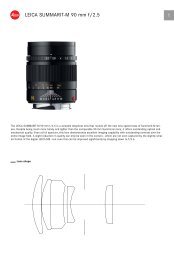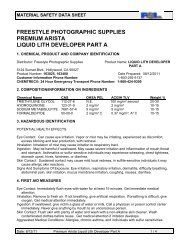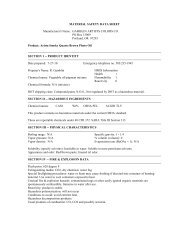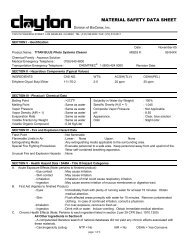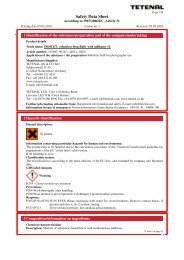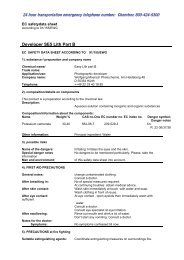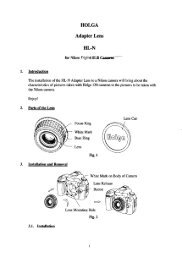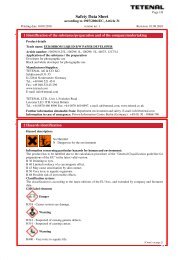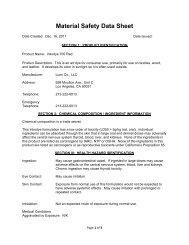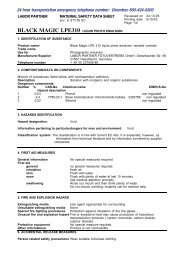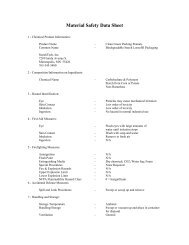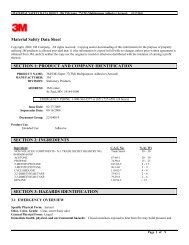KODAK Developer - Freestyle Photographic Supplies
KODAK Developer - Freestyle Photographic Supplies
KODAK Developer - Freestyle Photographic Supplies
Create successful ePaper yourself
Turn your PDF publications into a flip-book with our unique Google optimized e-Paper software.
Revision Date: 04/14/2008<br />
000000025621/Version: 1.0<br />
Print Date: 01/26/2009<br />
Page: 4/8<br />
Material Safety Data Sheet<br />
suspected carcinogenic or mutagenic substance in humans. No increases in cancer rates were<br />
observed in an epidemiology study which looked at mortality among more than 800 persons<br />
employed primarily in the manufacture of hydroquinone. Carcinogenicity studies in animals<br />
were inconclusive. Rats and mice were given hydroquinone by stomach tube or at high<br />
concentrations in the diet. Responses were not consistent across route of exposure, species or<br />
sex. The International Agency for Research on Cancer (IARC) has classified hydroquinone in<br />
Group 3, i.e., "not classifiable" as a carcinogen. Hydroquinone is generally negative in bacterial<br />
mutagenicity tests; there is evidence for the clastogenicity (chromosome breakage) of<br />
hydroquinone in vivo and in vitro. The relevance of chromosomal effects in test animals in<br />
predicting human risk is unclear.<br />
Contains: Sodium tetraborate. Based on repeated-dose ingestion studies in animals, may<br />
cause adverse reproductive and developmental effects. However, the doses administered were<br />
many times those to which humans would normally be exposed.<br />
Contains: Bis(4-hydroxy-N-methylanilinium) sulphate. Based on animal data, may cause<br />
adverse effects on the following organs/systems: blood, kidney, spleen. Based on animal data<br />
this material can produce methemoglobin which, in sufficient concentration, causes cyanosis, a<br />
blue-gray discoloration of the skin and lips caused by a reduced ability of the blood to carry<br />
oxygen.<br />
Inhalation: Expected to be a low hazard for recommended handling. Some asthmatics or<br />
hypersensitive individuals may experience difficult breathing after inhaling sulfite salts.<br />
Eyes: Causes eye irritation. Airborne dust/mist/vapor irritating.<br />
Skin: Causes skin irritation. May cause allergic skin reaction.<br />
Ingestion: May be harmful if swallowed. Some asthmatics or sulfite-sensitive individuals may<br />
experience wheezing, chest tightness, stomach upset, hives, faintness, weakness and diarrhea.<br />
Data for Sodium sulphite (CAS 7757-83-7):<br />
Acute Toxicity Data:<br />
• Oral LD50 (rat): > 1,600 mg/kg<br />
• Skin irritation: none<br />
• Eye irritation: slight; washing palliative<br />
Data for Hydroquinone (CAS 123-31-9):<br />
Acute Toxicity Data:<br />
• Oral LD50 (rat): 400 mg/kg<br />
• Oral LD50 (male rat): 400 mg/kg<br />
• Oral LD50 (male mouse): 100 - 200 mg/kg<br />
• Dermal LD50 (guinea pig): > 1,000 mg/kg<br />
• Dermal absorption rate: 1.1 micrograms (s) / cm 2 / hour<br />
• Skin irritation: slight<br />
• Skin Sensitization (guinea pig): positive<br />
• Eye irritation: moderate<br />
Mutagenicity/Genotoxicity Data:




